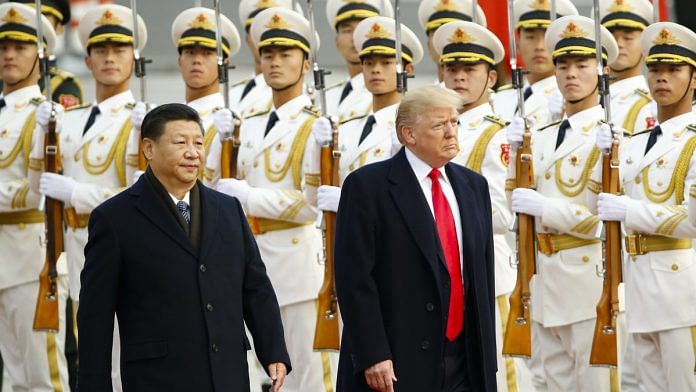New Delhi: After the US-China trade negotiations fell apart last week, the Trump administration hiked tariffs from 10 to 25 per cent on $200 billion worth of Chinese imports while threatening levies on Chinese goods worth another $300 billion. Beijing responded by implementing retaliatory tariffs on $60 billion worth of US imports from 1 June.
This has rattled stock markets across the world and is leading to widespread uncertainty among firms and investors.
A tariff is a tax on imports or exports, and is used to provide protection to a domestic industry from foreign competition.
This is the third wave of tariff hikes in the ongoing US-China trade war, which started in January last year. At the heart of US’ grievances is its ever-expanding trade deficit, especially with countries such as China.
Given these developments, ThePrint looks at the plausible American strategy behind this trade war and situates it in the historical context.
Evolution of global trade
It is nearly impossible to compare the recent trade war with anything else from history. The reason is that, before 1945, the world had never seen a rules-based global trading regime.
In a December 2013 research paper, economists Douglas Irwin and Kevin O’Rourke provided a comprehensive account of the multilateral trading system in a historical perspective.
They broke down recent trading history into four distinct periods: Non-system of the mercantilist era, informal system of the 19th century, non-system of the inter-war period, and the post-war multilateral trading system, and saw how each phase dealt with shocks and shifts.
The mercantilist era (between 1492 and the Industrial Revolution in the 18th-19th century) had no system and each country only looked to maximise its own self-interest.
During the 19th century, the informal system featured relatively open economies, but several economic shocks and long-term shifts in comparative advantage eventually destroyed that system, according to the authors.
These days, when countries adopt protectionism and retaliatory protectionism, most scholars highlight the inter-war period and how a global trade war destroyed the world economy.
As a reaction to the Great Depression, the US government adopted the Smoot-Hawley tariffs in 1930, which were met by retaliatory tariffs from all the major economies. This further exacerbated the economic effects of the Great Depression.
The post-war multilateral trade regime
From the ashes of the inter-war breakdown rose the new global trading regime. In the post-war era, the General Agreement on Tariffs and Trade (GATT) and then its successor, the World Trade Organization (WTO), have regulated global trade.
These organisations established a rules-based trading order, whereby countries could not arbitrarily hike tariffs against each other.
In case a country found another’s trade practices to be unfair, the row was to be brought to the WTO — over the years, it has often been settled via consultation behind closed doors, before dispute resolution even began.
Also read: Why China isn’t standing by Iran while its trade war with US continues
Trump’s power-centric bargaining strategy
Donald Trump won the 2016 US presidential election on a clarion call to “Make America Great Again”, promising to protect local businesses against what he described as the unfair trade practices of countries such as China. The Trump administration, with its tariffs, has chosen to completely bypass the WTO.
In a paper published last month, economists Aaditya Mattoo and Robert Staiger noted that, under Trump, the US had moved away from rules-based bargaining to power-centric bargaining.
They argued that the US strategy could be explained by two factors. First, the tariff levels between the US and other advanced industrial economies are already near-zero. Renegotiating trade agreements would reallocate trade, but not increase it.
Second, developing countries already have near-complete access to the US markets. A successful negotiation requires give and take — and the US doesn’t have much to offer to China. This rules out mutually lowering trade barriers.
In such a scenario, the US has adopted the tactics of “bargaining tariffs”. The plausible thinking in the Trump administration is that the US has a greater ability to endure these tariffs than China. Hence, eventually, China would be forced to concede to the US’ demands.
The effects of such a power-based negotiation strategy
Trump’s hardball negotiation strategy has failed in almost all cases.
Krzysztof Pelc, an associate professor at McGill University, Canada, argued in an article for Literary Review of Canada, that, by establishing institutions such as the GATT in the post-war era, the US effectively constrained its use of power through a set of trading rules.
By 1980s, when the US’ economic power had relatively declined, these institutions allowed Washington to sustain its influence as all countries now abided by American liberal principles when conducting foreign trade.
But, under Trump, the US is seen to be destroying that very multilateral trading order.
“Unilateralism breeds disproportionate resistance, even when it is backed up with considerable power,” Pelc wrote. And this is what is happening — from Mexico to China and EU to India, several countries are ganging up against American protectionism.
“To the extent that US actions cause permanent damage to the rules-based system, the United States may ultimately suffer from the absence of restraints on the actions of a future hegemon,” Mattoo and Staiger wrote.
While the average US consumer has reportedly had to pay for the rise in tariffs, more fundamentally, the increased levies have wreaked havoc on the global value chains-driven manufacturing.
In the past, with such tariff hikes, production could be diverted to different countries. Today, with vertical integration, the process to manufacture a single product involves several countries.
Hence, the rise of tariffs in one of the countries disrupts the entire supply chain and raises the cost of production. This explains the recent panic in the markets.
Also read: Amid trade war with US, China’s growth records slowest rate since 1990



